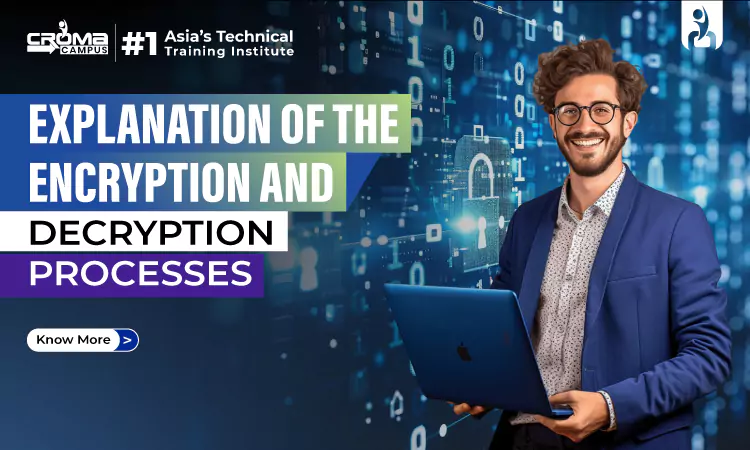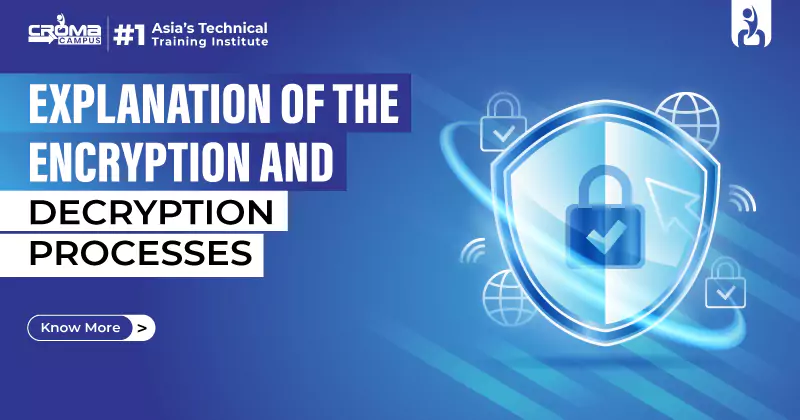Explanation Of The Encryption And Decryption Processes
4.9 out of 5 based on 10596 votesLast updated on 24th Jul 2024 13.59K Views
- Bookmark

Understand encryption & decryption: encryption scrambles data to protect it, while decryption reverses the process to make it readable again.

In the current digital dominating space, the protection of sensitive information is genuinely important. Encryption and decryption are fundamental processes that safeguard data from unauthorized access, assuring confidentiality, integrity, and authenticity. These processes are integral to a wide range of applications, from securing online transactions to protecting personal communications. Further in this web blog, we will have a look at the explanation of encryption and decryption from the Caesar ii Certification, along with highlighting their significance in modern cyber-security.
What Encryption Refers to?
Encryption is a legitimate process of converting plain text or readable data into an unintelligible form, known as ciphertext, using an algorithm and an encryption key. The primary goal of encryption is to ensure that data remains confidential and can only be accessed by authorized parties. This transformation hence renders the data unreadable to anyone who does not possess the decryption key, effectively protecting it from interception or eavesdropping.
Let's now proceed further, and know the whole process of Encryption.
Note: Are you a working professional and looking for an Online Piping Design Course, visit Croma Campus and boost your career in this faster-growing field. Get 100% job assistance & discounts on your fees.
Know the Process of Encryption
The encryption process involves several key steps:
- Plaintext Input:- The data to be encrypted, known as plaintext, is provided as input. This data can be anything from a simple text message to a complex digital file.
- Key Generation- A key, which is a sequence of bits used to encrypt the plaintext, is generated. The key can be symmetric or asymmetric, depending on the encryption method used.
- Algorithm Application-The encryption algorithm, which is a set of mathematical rules and procedures, is applied to the plaintext using the key. The algorithm transforms the plaintext into cipher-text, ensuring that the data becomes unreadable without the corresponding decryption key.
- Cipher-text Output- The resulting cipher-text is produced as the output. This encrypted data can be securely transmitted or stored, as it is protected from unauthorized access.
What Decryption Refers to?
Decryption is the reverse process of encryption, converting cipher-text back into its original, readable form, known as plaintext. Decryption requires the use of a decryption key, which must correspond to the encryption key used in the encryption process. The purpose of decryption is to allow authorized parties to access and understand the encrypted data.
Note: In plant designing, Sp3d Admin Training will be helpful for professionals who are looking to make career in this field. So for better understanding please visit Croma Campus and get fee consultation now.
Know the Process of Decryption
The legit decryption process mirrors the encryption process and involves a few steps which are as follows:-
- Cipher-text Input- The encrypted data, or cipher-text, is provided as input. This data has been previously encrypted and is currently unreadable.
- Key Retrieval- The decryption key, which is either the same as the encryption key (in symmetric encryption) or a different but mathematically related key (in asymmetric encryption), is retrieved.
- Algorithm Application- The decryption algorithm, which is designed to reverse the encryption process, is applied to the cipher-text using the decryption key. This algorithm transforms the cipher-text back into its original plaintext form.
- Plaintext Output- The resulting plaintext is produced as the output, making the data readable and accessible to authorized parties.
You May Also Read These Posts:
Caesar II Installation Guide Step By Step
Essential Tips For Effective Caesar II Training
Difference Between Piping Engineer And Piping Designer
Future Scope Of Google SketchUp
Know the Importance of both Encryption & Decryption Processes
Both these processes offer several critical benefits:-
- Encryption ensures that sensitive information remains confidential and can only be accessed by authorized individuals. This is crucial for protecting personal data, financial information, and confidential communications.
- It also helps in maintaining data integrity by preventing unauthorized alterations. When combined with hash functions, encryption can detect and prevent tampering, ensuring that data remains accurate and reliable.
- In fact, it also supports authentication by verifying the identities of parties involved in communication. Digital signatures, which are created using asymmetric encryption, provide a way to authenticate the sender of a message and ensure that it has not been altered.
- Well, numerous industries are also subject to regulations that require the use of encryption to protect sensitive data. Compliance with these regulations is essential for avoiding legal penalties and maintaining customer trust.
- It is one of the important tools that are required for preventing data breaches and mitigating their impact. Even if encrypted data is intercepted or stolen, it remains unreadable and useless to unauthorized parties.
Note: SP3d is one of the leading software and technology, which is used in plant designing. So if you are looking for SP3D Online Training, you can visit Croma Campus and get free consultation with discounted fees as well.
Know where Encryption and Decryption are Highly Utilized?
In the present scenario, encryption and decryption are used in a wide range of real-world applications:
- Email services, messaging apps, and VoIP systems use encryption to protect communications from eavesdropping and interception.
- E-commerce platforms, online banking services, and payment gateways employ encryption to secure financial transactions and protect sensitive customer information.
- Numerous kinds of companies utilize encryption to protect data stored on servers, databases, and cloud storage services. This ensures that sensitive information remains secure even if physical security measures are compromised.
- In fact, VPNs use encryption to create secure, encrypted tunnels for internet traffic, protecting data from interception and ensuring privacy.
- Its end-to-end encryption is also used in communication apps and services to ensure that only the communicating parties can read the messages, providing the highest level of privacy and security.
Is Learning Encryption and Decryption Difficult or Easy?
Learning encryption and decryption can be both challenging and rewarding, depending on one's background and the depth of understanding desired. For beginners, grasping the basic concepts and principles of encryption is relatively a bit complex. Fundamental topics like symmetric and asymmetric encryption, hash functions, and the general workings of encryption algorithms can be understood with some effort and dedication.
On the other hand, in the present digital age, there are numerous resources available, including various tutorials, and textbooks that break down these concepts into manageable parts. For those with a background in computer science or a related field, the initial learning step might seem easy, whereas many foundational concepts overlap with other areas of study.
However, mastering encryption and decryption at an advanced level and making a career out of it might become a bit challenging, but can be learnt.
This normally involves indulging in the mathematical underpinnings of various encryption algorithms, understanding cryptographic protocols, and keeping up with the latest developments in the field. Advanced topics like- elliptic curve cryptography, quantum-resistant algorithms, and cryptographic key management require a solid understanding of higher mathematics and computer science.
Additionally, the field of cryptography is consecutively evolving, with new threats and vulnerabilities emerging regularly. Therefore, a deep and on-going commitment to learning is quite important for those who desire to specialize in cryptography or work in cyber-security roles where encryption is a critical component.
Note: Good News for learners staying in Delhi, if you are looking for a Piping Design Course in Delhi, you can enroll in us and get a 10% additional discount on your fee. Grab the deal now.
Key-point Differences Between Encryption and Decryption
Encryption and decryption are two fundamental processes in cryptography that serve distinct purposes. Encryption is the process of converting plaintext, which is readable data, into cipher-text, an unreadable format, using an algorithm and an encryption key. The primary objective of encryption is to ensure data confidentiality, preventing unauthorized access during transmission or storage. It uses various algorithms, like- AES, DES, RSA, and ECC, to achieve this transformation. Depending on the encryption type, a single key (symmetric encryption) or a pair of keys (asymmetric encryption) is used. In symmetric encryption, the same key is employed for both encryption and decryption, while in asymmetric encryption, a public key encrypts the data, and a corresponding private key decrypts it.
Decryption, on the other hand, is the reverse process of encryption. It involves converting cipher-text back into its original plaintext form using an algorithm and a decryption key. The purpose of decryption is to allow authorized parties to access and read the encrypted data. In symmetric encryption, the same key used for encryption is also used for decryption, whereas in asymmetric encryption, the private key decrypts the data that was encrypted with the public key. The decryption process ensures that data remains secure and accessible only to those with the appropriate key. Together, encryption and decryption provide a robust mechanism for protecting data integrity and privacy, crucial for secure communications and information storage in various applications.
Conclusion
From the information listed above, it's quite clear that both Encryption and decryption are essential processes for Caesar 2 Training and securing data in the digital age. They also provide the means to protect sensitive information, maintain data integrity, and assure the authenticity of communications. Knowing the mechanisms and significance of these processes is genuinely important in the current scenario for navigating the complexities of modern cyber-security. As technology continues to evolve at a rapid pace, the role of encryption and decryption will only become more vital in safeguarding our digital lives. So, learning this whole process will be a huge boon for your career graph.
Subscribe For Free Demo
Free Demo for Corporate & Online Trainings.



.webp)





















.webp)

.png)















